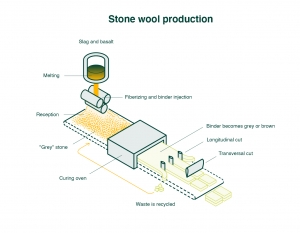Mineral wool, otherwise known as rock wool or stone wool, has been widely used for more than 60 years. It is made from volcanic rock such as basalt, which is solidified lava that forms when rock melts underground and quickly cools down. The process is mainly powered by coke, which is a form of coal. When the basalt rock is partially crushed, the bigger pieces are separated from finer particles; these are processed as briquettes which are used in the production of mineral wool.
The rock and briquettes are melted at high temperatures typically between 1,300°C to 1,500°C and then spun with steel slag to form fibres, comparable to wool or cotton candy, taking its final shape in a curing oven at a temperature of around 200°C. Towards the end of the production line, it is cut into the required shape and size and is packaged up into batts, rolls or slabs.
Mineral wool consists of up to 70% recycled materials and is often seen as much easier to handle due to being easier to cut, move and fit into place. It also has effective sound-absorbing, moisture-resistant and fire-resistant properties.

Image sourced from Eurima
It is easy to get mineral wool and glass wool confused, but these are, in fact, different products with different insulating capacities. If you have any further queries then please don’t hesitate to contact us.

